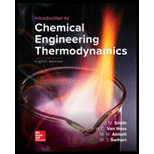
(a)
Interpretation :
Determine the dewpoint temperature of the mixture and the composition of the first condensate if a system is condensed at constant pressure.
Concept Introduction :
At dew point of the system, the gas phase composition (y) remains the same as the overall composition of the system (z) because at the dew point, a small droplet of the liquid will form which has the negligible composition.
In condensation, the layer which has less dew point temperature, will come later and vice versa.
(b)
Interpretation :
Determine the temperature at which the second liquid phase appears and its initial composition.
Concept Introduction :
After the further condensation of mixture, the vapor composition of water will change but the heptane and pentane have same composition as before. So, at the temperature where first drop of hydrocarbon layer will show up, the following ratio shall be valid
(c)
Interpretation :
Determine the bubblepoint temperature and the composition of the last bubble of the vapor.
Concept Introduction :
At bubble point of the system, the liquid phase composition (y) remains the same as the overall composition of the system (z) because at the bubble point, a small droplet of the bubbleremains in the system after the condensation which has the negligible composition and for two immiscible layers mixture we already know that
Want to see the full answer?
Check out a sample textbook solution
Chapter 15 Solutions
Introduction to Chemical Engineering Thermodynamics
 Introduction to Chemical Engineering Thermodynami...Chemical EngineeringISBN:9781259696527Author:J.M. Smith Termodinamica en ingenieria quimica, Hendrick C Van Ness, Michael Abbott, Mark SwihartPublisher:McGraw-Hill Education
Introduction to Chemical Engineering Thermodynami...Chemical EngineeringISBN:9781259696527Author:J.M. Smith Termodinamica en ingenieria quimica, Hendrick C Van Ness, Michael Abbott, Mark SwihartPublisher:McGraw-Hill Education Elementary Principles of Chemical Processes, Bind...Chemical EngineeringISBN:9781118431221Author:Richard M. Felder, Ronald W. Rousseau, Lisa G. BullardPublisher:WILEY
Elementary Principles of Chemical Processes, Bind...Chemical EngineeringISBN:9781118431221Author:Richard M. Felder, Ronald W. Rousseau, Lisa G. BullardPublisher:WILEY Elements of Chemical Reaction Engineering (5th Ed...Chemical EngineeringISBN:9780133887518Author:H. Scott FoglerPublisher:Prentice Hall
Elements of Chemical Reaction Engineering (5th Ed...Chemical EngineeringISBN:9780133887518Author:H. Scott FoglerPublisher:Prentice Hall
 Industrial Plastics: Theory and ApplicationsChemical EngineeringISBN:9781285061238Author:Lokensgard, ErikPublisher:Delmar Cengage Learning
Industrial Plastics: Theory and ApplicationsChemical EngineeringISBN:9781285061238Author:Lokensgard, ErikPublisher:Delmar Cengage Learning Unit Operations of Chemical EngineeringChemical EngineeringISBN:9780072848236Author:Warren McCabe, Julian C. Smith, Peter HarriottPublisher:McGraw-Hill Companies, The
Unit Operations of Chemical EngineeringChemical EngineeringISBN:9780072848236Author:Warren McCabe, Julian C. Smith, Peter HarriottPublisher:McGraw-Hill Companies, The





